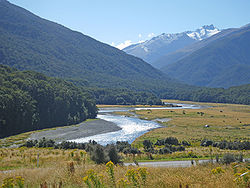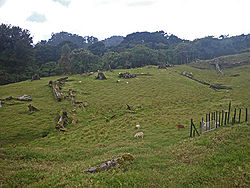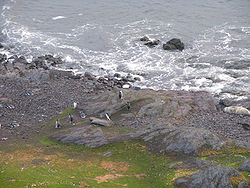Ecotone
Contents
Introduction
An ecotone is a transitional area between two different ecosystems, such as a forest and a grassland. In landscape ecology, an ecotone is the border area where two patches meet that have different ecological composition. The ecotone contains elements of both bordering communities as well as organisms which are characteristic and restricted to the ecotone. Ecotones can be a wide zone where two communities gradually change from one to another or a more abrupt boundary where the change from one association to another is sharply defined. An ecotone can occur very locally (as between a single field and an adjoining forest) or more regionally (as in those between two different biomes). The appearance of an ecotone varies depending on the scale of study. Thus, an ecotone can be studied at many spatial scales, from centimeters to thousands of kilometers. Ecotones are not limited to terrestrial communities; for example, the transition from soft bottom to hard bottom marine communities is an aquatic ecotone.
History of ecotone
The concept of an ecotone can be traced back to the work of Livington (1903) and Clements (1905). Livingston introduced an ecotone as “a stress line connecting points of accumulated or abrupt change.” Clements described boundaries between plant communities as "tension zones" with increased productivity and described the ecotone as “an environmentally stochastic stress zone” and “the tension line between zones and formations.” In the 1930s, ecotones were being studied by scientists in several disciplines. Leopold and other wildlife biologists were aware of and describing edges and margins as important habitat while Griggs (1938) studied the transitional zones at tree lines. In the 1950s, scientists like Weaver and Albertson were interested in large transitional areas, like those between the Arctic tundra and the boreal forest. Ecotones continue to be associated with characteristics that can be either similar or distinct from the adjacent communities.
Causes of an ecotone

An ecotone may be created by natural or man-made factors. Natural factors include abiotic factor transitions in soils composition, pH, soil salinity, soil mineral content as well as topographic and meteorological transition zones. Anthropogenic bases of ecotones can be such acts as forest clearing, pollution within a given soil area, overdrafting of groundwater in a well defined locale, or controlled burning.
Ecotones and edge effect
Ecotones often have a larger number of species and larger population densities than the communities on either side. This tendency for increased biodiversity within the ecotone is referred to as the "edge effect." Those species which occur primarily or most abundantly in the ecotones are called "edge" species. Although ecotones support an increase in density for some species, other species need interior habitat blocks to survive and show avoidance or poor survival on edges. An increase in anthropogenic fragmentation of landscapes creates more ecotones, which may result in an increased occurrence of edge species while simultaneously resulting in increased negative effects for interior species.
Ecotones and conservation
Ecotones can be characterized by the change of spatial and temporal variables, the contrast between patches on either side of the ecotone, and the smoothness of the transition zone. Ecotones are also dynamic, changing width and positions with time during Succession or environmental changes at various scales.
An ecotone may be important in facilitating the exchange of species and nutrients between communities. The characteristics of ecotones can contribute to or detract from the overall permeability of the landscape. Animals and plants interact with ecotones at many scales. Understanding how species perceive and relate to ecotones can facilitate conservation and management of those species. Ecotones have also been associated with increased nest predation (Predator-prey cycles) of interior habitat species at local levels, alien species, invasion at regional levels, and increased forest fragmentation and developed landscapes at larger scales.
Ecotones may also be important in ecology as indicators of global change. Current interest in ecotones relates to their sensitivity to changing climate and many scientists advocate monitoring ecotones to detect patterns of global change.
Related terms
An ecocline, described by Whitaker in 1967, is similar to an ecotone but often exhibits a more linear geometry. Additionally, while an ecocline is relatively heterogeneous transition zone, it is more environmentally stable than an ecotone.
Further reading
- Clements, F.E. 1905. Research methods in ecology. University Publishing Company, Lincoln, NE.
- Hansen, A.J. and F. diCastri, eds. 1992. Landscape boundaries: consequences for biotic diversity and ecological flows. Ecological Studies 92. Springer-Verlag, New York, New York.
- Hilty, J.A., W. Z. Lidicker Jr., A. M. Merenlender (eds.). 2006. Corridor Ecology: The Science and Practice of Linking Landscapse for Biodiversity Conservation. Island Press Washington.
- Odum, E.P. 1971. Fundamentals of Ecology. W.B. Saunders Company, Philadelphia: 157.
- Risser, P.G. 1995. The Status of the Science of Examining Ecotones. Bioscience, 45(5): 318-325.
This article was researched and written by a student at the University of Vermont participating in the Encyclopedia of Earth's (EoE) Student Science Communication Project. The project encourages students in undergraduate and graduate programs to write about timely scientific issues under close faculty guidance. All articles have been reviewed by internal EoE editors, and by independent experts on each topic.


